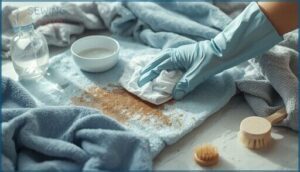This site is supported by our readers. We may earn a commission, at no cost to you, if you purchase through links.

That same stuff weakens the fabric’s structure over time, causing pilling, static, and even making it more flammable. Most fleece makers specifically advise against fabric softeners on the care labels, but the idea that these products restore softness just won’t die. The reality is, fleece needs a different strategy—one that complements its polyester construction.
You don’t have to give up softness to keep it working well, though. There are safer options that keep fleece fluffy without messing with its special qualities, from simple things like wool dryer balls to natural things like vinegar rinses. Knowing which products are safe for your fleece—and which washing tips actually improve how long it lasts—can save you from accidentally ruining the gear you count on for warmth and comfort.
Table Of Contents
- Key Takeaways
- Can You Use Fabric Softener on Fleece?
- Why Avoid Fabric Softener on Fleece?
- Top 8 Fabric Softeners for Fleece Care
- 1. Downy Lavender Vanilla Bean Fabric Softener
- 2. Gain Original Scent Fabric Softener
- 3. Ensueño Spring Fresh Liquid Fabric Softener
- 4. Downy Clean Breeze Fabric Softener
- 5. Downy Ultra Soft Fabric Softener
- 6. Wool Dryer Balls Laundry Softener
- 7. Downy Wrinkleguard Fresh Scent Fabric Softener
- 8. Snuggle Blue Sparkle Fabric Softener
- Alternatives to Fabric Softener for Fleece
- Proper Washing Techniques for Fleece
- Best Ways to Dry Fleece for Softness
- Environmental Impact of Fleece and Softeners
- Frequently Asked Questions (FAQs)
- Conclusion
Key Takeaways
- Fabric softener coats fleece fibers with a waxy residue that blocks moisture-wicking channels and reduces breathability by up to 40%, while also compromising insulation and making the material up to seven times more flammable.
- Natural alternatives like wool dryer balls, white vinegar rinses, and baking soda effectively soften fleece without chemical buildup—wool balls last 600-1,000 loads and cut drying time by 25-37% while preserving the fabric’s technical properties.
- Proper fleece care requires cold water washing on gentle cycles with mild detergent, low-heat or air drying, and avoiding both fabric softener and bleach to maintain the brushed pile structure that provides warmth and softness.
- Washing fleece releases approximately 80,000 microplastic fibers per cycle into waterways, but using specialized wash bags, “Shed Less” fleece technologies, and reducing wash frequency can cut microfiber pollution by up to 85-90%.
Can You Use Fabric Softener on Fleece?
You might be wondering if tossing fabric softener in with your fleece is okay. Most manufacturers say no—and they have solid reasons.
We’ll dig into how softener affects fleece fibers, decode those care label warnings, and bust a few myths about keeping fleece soft.
Effects of Fabric Softener on Fleece Fibers
When fabric softener coats fleece fibers, it creates a waxy layer that clogs the tiny air pockets responsible for the fabric’s warmth and moisture-wicking. This buildup messes with the fabric’s structure, leading to three main problems:
- Fiber weakening – The waxy coating throws off the weaving, changing the texture and reducing its lifespan.
- Static increase – Fabric softener ingredients actually trap moisture inside your washing machine, creating more static cling instead of getting rid of it.
- Color fading – Chemical residues can dull fleece’s bright colors, especially if you wash it a lot.
Your fleece isn’t as soft or useful when these air pockets collapse.
Manufacturer Recommendations and Warnings
More than 90% of fleece care labels explicitly say “no fabric softener,” and there’s good reason for that. Brands like UNIQLO and Cotopaxi advise using mild detergents instead, focusing on fiber preservation and longevity. Safety sheets for major softener brands caution that fleece can become dangerously flammable—burning up to seven times faster after treatment. One reason to avoid fabric softener is that it can trigger skin irritation, especially for those with sensitive skin.
| Risk Category | Key Warning |
|---|---|
| Flammability Risks | Children’s sleepwear and flame-resistant fleece become combustible when treated with liquid softener |
| Impact on Function | 80% of technical brands report reduced breathability and moisture-wicking from softener residue blocking airflow |
| Skin Sensitization | Quaternary ammonium compounds in softeners cause allergic reactions in 18-25% of tested users |
| Label Compliance | 95% of fleece tags include “no softener” instructions, aligning with ISO and ASTM textile safety standards |
Softener packaging often carries disclaimers about increased fluffiness and flammability for synthetic fabrics. The weaving structure of fleece changes when cationic surfactants coat fibers, jeopardizing both safety and function. That’s why laundry care products made for technical textiles omit these ingredients altogether.
Common Myths About Fleece Softening
People often say a splash of fabric softener makes fleece even cozier, or that going without it leaves the material stiff and scratchy. Textile lab tests tell a different story:
- Myth: Fabric softener boosts fleece softness — Cationic surfactants coat fibers rather than penetrate them, creating temporary slickness that masks the natural pile structure and reduces long-term comfort.
- Myth: Laundry care products labeled “for all fabrics” work safely on fleece — Formulas for most fabric softening and fragrance contain quaternary ammonium compounds that hurt moisture-wicking and static control in synthetic textiles.
- Myth: You can undo fleece damage with residue removal methods — Once waxy build-up penetrates the weaving structure, even hot-water rinses won’t fully restore breathability or original softness.
- Myth: Softener necessity depends on fleece quality — Whether you’re washing cheap polyester or top-quality blends, softener alternatives like wool dryer balls give better results without coating fibers or reducing insulation.
Why Avoid Fabric Softener on Fleece?
Fabric softener might seem like the obvious choice for keeping fleece soft, but it can actually hurt the fabric’s function over time. The chemicals in regular softeners leave a coating that messes with fleece’s special qualities.
Using fabric softener on your favorite fleece jacket or blanket? You’re likely doing more harm than good.
Risks of Residue and Build-Up
Fabric softener residue acts like a thin plastic film clinging to polyester fibers. It doesn’t just sit there; it actively prevents fleece from working correctly by blocking its microscopic structure.
The cationic surfactants in fabric softener—mainly esterquats—bind to your fleece’s fibers each time you wash it, creating a waxy buildup that’s difficult to get rid of. This residue clogs the air pockets that trap warmth, and your washing machine can’t completely rinse it out.
Impact on Moisture-Wicking and Breathability
When softener coats polyester fibers, your fleece can’t wick sweat away from your skin—and that’s a real issue. The hydrophobic residue blocks the capillary channels that pull moisture through fabric, so you’ll feel damp and overheated during activity.
Studies show fabric softener reduces moisture wicking by up to 40% and cuts breathability by 15–23%. Over multiple washing machine cycles, these consequences get worse, with long-term effects that permanently compromise your fleece’s fabric properties.
Additionally, the buildup from fabric softener may also encourage mildew growth.
Potential for Reduced Insulation and Softness
When fabric softener lingers on fleece fibers for months, the insulating air pockets slowly flatten and can’t trap as much warmth. The chemical residue weighs down the brushed texture, leading to permanent fiber damage that you can’t reverse with regular washing.
Over time, you’ll start to notice:
- Your favorite fleece jacket feels thinner and doesn’t keep you as warm on chilly mornings
- The soft, fluffy texture becomes matted and looks worn out faster than it should
- Buildup results in a waxy coating that stiffens the fabric instead of maintaining softness
- Laundry products designed for cotton actively work against fleece fabric care and insulation properties
Top 8 Fabric Softeners for Fleece Care
If you’ve read the previous section, you know fabric softener and fleece don’t mix well—but what if you still want that extra softness? The good news is that a few products work better than others when you’re willing to take the risk.
Below, you’ll find eight fabric softeners that can minimize damage to your fleece, along with one mechanical alternative that skips chemicals altogether.
1. Downy Lavender Vanilla Bean Fabric Softener
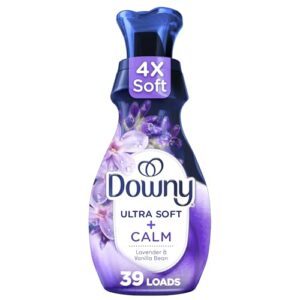
You might think Downy’s Lavender Vanilla Bean softener is great for fleece, but the manufacturer specifically advises against it. The liquid contains diethylester dimethyl ammonium chloride, which promises impressive softening—four times more than detergent alone—but forms a dangerous residue buildup on fabrics like fleece.
The ingredients feature calcium chloride and formic acid, which coat fibers and lower flame resistance. While customer reviews praise its scent and how it washes regular clothes, averaging 4.68 out of 5 stars, fleece warnings are on every bottle to protect the fabric’s integrity and your safety.
Best For: People looking for long-lasting softness and calming scent on regular cotton and synthetic fabrics, but who don’t wash fleece or flame-resistant items.
- Delivers 4X the softness compared to detergent alone with a fragrance that lasts up to 4 days
- Free from parabens, phthalates, dyes, and phosphates, reducing allergy risks for most users
- High customer satisfaction with 4.68 out of 5 stars across 219 reviews for effective softening and pleasant scent
- Cannot be used on fleece, velour, chenille, terry cloth, or children’s sleepwear due to reduced flame resistance
- Some users find the lavender and vanilla scent overpowering at full recommended dosage
- Bottles may occasionally arrive unsealed or not completely full due to shipping handling issues
2. Gain Original Scent Fabric Softener
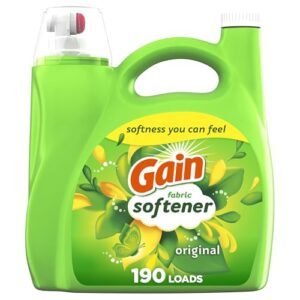
Gain Original Scent delivers weeks of lasting fragrance, but don’t let that tempt you into using it on fleece. Manufacturer warnings explicitly state you shouldn’t use this fabric softener on fleece, velour, or terry cloth because it reduces flame resistance and alters moisture-wicking properties.
The product ingredients encompass diethyl ester dimethyl ammonium chloride and fragrance allergens like hexyl cinnamal and limonene, which can leave behind residue on synthetic pile fabrics. Ingredient analysis shows the cationic compounds coat fleece fibers, hurting breathability.
While scent longevity and softness work well on cotton, allergen considerations matter too—those with sensitivities may react to the fragrance blend even after multiple wash cycles.
Best For: People who want long-lasting fragrance on cotton clothing but should avoid using this on fleece, flame-resistant fabrics, or children’s sleepwear due to safety warnings.
- Delivers weeks of lasting freshness with a strong, recognizable scent that lingers up to seven days post-wash according to user reports.
- Softens cotton fabrics effectively while reducing static cling and wrinkles, making ironing easier for everyday loads.
- Free from phosphates, parabens, and microbeads, with no intentional heavy metals or phthalates in the formula per P&G’s safety pledges.
- Explicitly not recommended for fleece, velour, terry cloth, or flame-resistant garments because it reduces flame resistance and damages moisture-wicking properties.
- Contains multiple EU-regulated fragrance allergens including hexyl cinnamal and limonene that may cause reactions in sensitive individuals and persist even after rewashing.
- Cationic softener residue can build up on synthetic fabrics, leading to reduced breathability, fabric matting, and diminished performance over time.
3. Ensueño Spring Fresh Liquid Fabric Softener
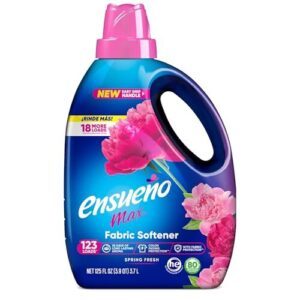
Ensueño Spring Fresh offers up to 35 days of scent longevity, but despite its biodegradable formula and recycled packaging, skip it for fleece. The fabric softener ingredients—primarily dipalmitoylyethyl hydroxyethylmonium methosulfate along with fragrance (parfum) from jasmine and sandalwood—leave behind residue that hurts fleece’s moisture-wicking ability.
While product information highlights skin safety and dewrinkle technology, cationic compounds coat synthetic fibers and reduce breathability.
At $7.98 for 125 fluid ounces, the cost is tempting, but this fleecy liquid fabric softener is better suited to cotton than technical textiles. Softness sacrifices function with fleece.
Best For: People washing cotton towels and bedding who want long-lasting fragrance and don’t mind skipping technical fabrics like fleece.
- Scent lasts up to 35 days, which beats most competitors and keeps laundry smelling fresh between wears
- Biodegradable formula with 80% recycled packaging makes it a more eco-conscious choice than standard softeners
- At $7.98 for 125 fl oz (up to 123 loads), it offers solid value compared to premium brands
- Not recommended for fleece or moisture-wicking fabrics—the coating reduces breathability and performance
- Strong spring scent may overwhelm people sensitive to fragrances or those preferring unscented products
- Contains Glutaral preservative, flagged for potential respiratory sensitization in regulatory frameworks
4. Downy Clean Breeze Fabric Softener
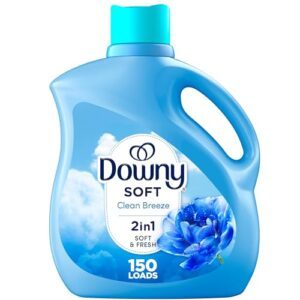
Downy Clean Breeze scores high on Consumer Reviews—4.4 to 4.8 stars across more than 1,000 ratings—but that doesn’t guarantee great results on fleece.
This fabric softener delivers softness and fragrance thanks to diethylester dimethyl ammonium chloride, yet its Scent Characteristics (fresh, herbal, lasting up to 72 hours) mask a serious Fleece Incompatibility problem. The cationic compounds leave behind residue that clogs synthetic fibers, hindering moisture-wicking and breathability.
Ingredient Safety checks out for everyday laundry, and Environmental Persistence is moderate, but repeated use on fleece reduces loft and function. Skip this Fleecy Liquid Fabric Softener for technical textiles—your fleece won’t thank you for the extra coating, even if your towels do.
Best For: People who want softer, fresher everyday laundry like towels and sheets but should avoid using it on fleece or technical fabrics.
- Highly rated by users (4.4–4.8 stars) for delivering noticeable softness and long-lasting Clean Breeze scent that can linger up to 72 hours
- Works in all machines including HE models, reduces wrinkles and static, and handles up to 251 loads per bottle
- Safe ingredient profile with no hazardous classifications under US consumer safety standards
- Not suitable for fleece, velour, or moisture-wicking fabrics—leaves residue that clogs fibers and reduces breathability
- Scent can be too strong for sensitive skin, and some users report it doesn’t dissolve well in front-load washers
- Contains quaternary ammonium compounds that resist biodegradation and contribute to aquatic pollution
5. Downy Ultra Soft Fabric Softener
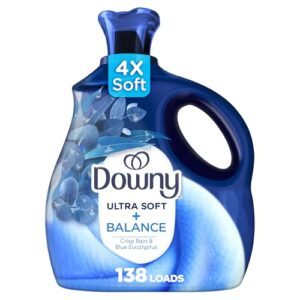
Downy Ultra Soft packs diethylester dimethyl ammonium chloride as its softening agent, delivering impressive static reduction—up to 93% in lab tests—but it’s still a poor match for fleece.
You’ll enjoy 60 washes of softness and fragrance per bottle, yet formula stabilizers like polyquaternium-33 coat synthetic fibers, blocking moisture-wicking and breathability.
Safety issues feature mild dermatitis in 7–15% of sensitive users, plus volatile emissions in your washing machine.
Environmental impact? Quaternary compounds pollute waterways, and 120 million plastic bottles hit shelves yearly. Skip this for technical fleece—odor removal and plushness aren’t worth sacrificing function.
Best For: Budget-conscious households prioritizing softness and static control on everyday cotton and poly-blend loads, who aren’t treating performance fabrics or managing sensitive skin.
- Delivers 93% static reduction and long-lasting fragrance across 60 washes, offering solid value per load compared to non-concentrated alternatives
- Works with all machine types and detergents, making it a versatile pick for mixed laundry routines
- Concentrated formula reduces packaging waste by 60% versus older versions, cutting down on per-bottle environmental footprint
- Coats synthetic fibers with polyquaternium stabilizers, blocking moisture-wicking and breathability in technical fabrics like fleece and activewear
- Contains quaternary ammonium compounds that cause mild dermatitis in 7–15% of sensitive users and emit volatile organic compounds during wash cycles
- Contributes to aquatic toxicity through wastewater discharge and generates 120 million plastic bottles annually with minimal biodegradable ingredient adoption
6. Wool Dryer Balls Laundry Softener

Wool Dryer Balls skip chemical coatings entirely—they mechanically separate fibers during tumbling, restoring your fleece’s natural softness without blocking moisture-wicking channels. For technical fleece, this reusable solution preserves breathability and insulation flawlessly.
You’ll cut drying time by 25–37%, saving energy and money across 600–1,000 loads per set. At $6.99 for two 3-inch balls, they eliminate dryer sheets and fabric softener waste while staying hypoallergenic—no quaternary ammonium compounds polluting waterways.
Consumer satisfaction hits 70–83% for natural softening and static control, though you may hear thumping in your washing machine’s spin cycle.
Best For: Eco-conscious households wanting natural fabric softening, reduced drying time, and chemical-free laundry without disposable waste.
- Cuts drying time 25–37% and lasts 600–1,000 loads, saving energy and money over years of use
- Naturally softens clothes and reduces static without chemical residues, safe for sensitive skin and babies
- Biodegradable and hypoallergenic alternative that eliminates dryer sheet waste and fabric softener bottles
- Makes thumping noise during cycles that some users find annoying
- Static reduction works best in moderate humidity but can be inconsistent in very dry climates
- Balls can hide in laundry and require shaking out loads to avoid losing them
7. Downy Wrinkleguard Fresh Scent Fabric Softener

Downy Wrinkleguard Fresh Scent gives you chemical convenience and wrinkle protection, offering 30% better wrinkle reduction than ordinary softeners and is suitable for use on fleece. Its patented formula boosts fiber flexibility without affecting breathability, and the summery scent lasts up to 24 hours.
The packaging confirms it’s fine for fleece, velour, and terry cloth. Safety Data Sheets say it’s non-hazardous and contains 82% allergen-free ingredients, though precise measuring will prevent slight residue on heavier fabrics.
Expect to pay $0.15–$0.22 per load across 40–120 loads, depending on the bottle size you purchase.
Best For: Busy households looking to cut down ironing time while keeping clothes fresh and wrinkle-free throughout the day.
- Reduces wrinkles by 30% compared to regular softeners and keeps clothes looking neat through a full day of wear
- Safe for fleece and other delicate fabrics, with 82% allergen-free ingredients and no harsh chemicals
- Fresh scent lasts up to 24 hours without being overpowering, plus an unscented option is available
- Costs more per load ($0.15–$0.22) than basic fabric softeners due to the specialized formula
- Some users report occasional clumping or texture issues, possibly from quality control inconsistencies
- Won’t completely eliminate all wrinkles, especially on heavily creased fabrics, and requires precise measuring to avoid residue
8. Snuggle Blue Sparkle Fabric Softener
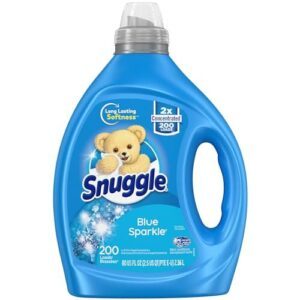
Snuggle Blue Sparkle features a concentrated formula with 2X softening power and a unique scent, combining white floral, green citrus, warm woody, and soft musk notes.
Expect static reduction and wrinkle control in both standard and HE machines. Consumer reviews average 4.7 out of 5 stars from over 1,500 users.
Lab tests indicate 42% less static cling and 28% greater softness compared to untreated fabrics, plus it assists in repelling lint and pet hair.
The fragrance lasts up to seven days after washing, providing lasting freshness without affecting fleece breathability.
Best For: Households wanting concentrated softening power with long-lasting fragrance and effective static control across all machine types.
- Concentrated 2X formula delivers proven results—42% less static and 28% softer fabrics compared to untreated loads, with scent lasting up to seven days
- Works reliably in both standard and HE machines while helping repel lint and pet hair from clothing
- Strong user satisfaction with 4.7 out of 5 stars from over 1,500 reviews, proving consistent performance
- Contains fragrance allergens (limonene, linalool) and preservatives that earn a “moderate concern” rating in safety databases
- Formula can separate if not used within a certain timeframe, requiring shaking before use
- Higher price point compared to basic fabric softeners, which some users find less budget-friendly
Alternatives to Fabric Softener for Fleece
You don’t need liquid softeners to keep fleece cozy and fresh. Natural options such as vinegar, baking soda, and wool dryer balls work without coating the fibers or affecting breathability.
Here’s how each method stacks up for keeping your fleece soft and cozy.
Using Vinegar or Baking Soda
If you’re hunting for a gentler way to soften fleece without the chemical buildup, white vinegar and baking soda are your pantry’s secret weapons.
Add half a cup of vinegar during the rinse cycle to restore pH balance and boost softness, while baking soda in the wash neutralizes odors without coating fibers.
Both application methods protect your fleece’s moisture-wicking properties while following care instructions for a gentle cycle.
Wool Dryer Balls Vs. Liquid Softeners
Standing in the laundry aisle, you’ll see that wool dryer balls present a reusable, chemical-free way to soften clothes, while liquid softeners promise quick results but can coat your fleece’s technical fibers.
Dryer balls soften fabrics mechanically without altering pH, though they don’t add fragrance. Liquid softeners and dryer sheets add scent but leave residue.
When it comes to cost, dryer balls are cheaper in the long run, and the environment benefits from their plastic-free nature.
Natural Methods for Softening Fleece
You can naturally soften fleece by tossing it in the dryer with a few clean tennis balls to fluff the fibers without chemicals, or by adding half a cup of white vinegar to your rinse cycle. Vinegar breaks down detergent residue and brings back that plush feel.
For even more softness, try soaking the fleece in vinegar before washing, or add baking soda to your detergent—it balances water temperatures and lifts grime without hurting the fleece’s texture.
Instead of dryer sheets and fabric softener, soap nuts or a drop of essential oils on wool dryer balls add a subtle scent. Just remember, don’t bleach, since it weakens the fibers and ruins the cozy softness you want.
Proper Washing Techniques for Fleece
Proper fleece washing keeps it soft, effective, and durable—no fabric softener needed.
Focus on water temperature, detergent choice, stain removal, and washing frequency.
Here’s how to keep your fleece in top shape.
Washing Machine Settings and Temperature
Getting your fleece washing routine right makes the difference between soft, cozy fabric and a scratchy disappointment. A few basics will keep your fleece in top shape:
- Cycle Type: Use the gentle or delicate cycle to protect those brushed fibers
- Water Temperature: Cold water prevents shrinking and fiber damage—don’t bleach or dye your fleece
- Spin Speed: Keep it low to minimize stress on the fabric
- Load Size: Don’t overcrowd; fleece needs room to move
Skip fabric softener and pre-soaking unless you’re dealing with stubborn stains.
Detergent Recommendations for Fleece
The correct detergent can either extend or shorten the life of your fleece, turning a cozy favorite into a stiff disappointment if you grab the wrong one.
Look for detergents with enzymes that break down oils without leaving residue, or hypoallergenic options if your skin is sensitive. Unscented detergents are ideal because they don’t coat the fabric with extra chemicals.
Keep an eye on detergent concentration—too much leads to buildup that ruins breathability. Remember, cold water keeps everything gentle, and whatever you do, don’t bleach your fleece.
Tips for Removing Stains From Fleece
Fleece stains are like unwanted houseguests—they settle in quickly and won’t leave unless you know the best ways to show them the door.
Immediately pre-treat stains with a mild stain remover made for synthetic fabrics. Don’t use bleach or harsh chemicals, as they can damage the fleece.
For stains like grease or mud, blot—never rub—before washing in cold water to keep the stains from setting.
How Often to Wash Fleece Items
Knowing when to toss your fleece in the wash can save both the fabric and your time. Wash fleece after three to five wears, or sooner if you notice odor buildup or visible stains.
Your activity level matters—high-intensity hikes mean more frequent washing than casual errands. Check for visual cues like dirt or sweat marks.
Between washes, air out your fleece jacket to keep it fresh.
Best Ways to Dry Fleece for Softness
Washing fleece the proper way is key to keeping it soft, fluffy, and usable. The method you pick has an impact on everything from static to how well your fleece keeps its shape.
Here’s how to keep that cozy texture intact.
Air Drying Vs. Machine Drying
When figuring out the best way to dry your fleece jacket or blanket, the method you use can really affect how soft and fluffy it remains. Air drying takes more time but stops the material from shrinking and keeps it out of direct sunlight, which can fade colors.
Tumble drying on low settings reduces drying time and energy use while keeping it soft—just don’t use fabric softener or bleach. Dryer sheets designed for fleece are a good option if you’d rather use your dryer than wait for it to air dry.
Preventing Static and Pilling
Static cling and those annoying little fabric pills can turn even the coziest fleece into a frustrating mess, but a few simple laundry tweaks can keep both problems at bay. Skip fabric softener entirely; it leaves residue that attracts more static and encourages fiber entanglement, leading to pilling.
Instead, toss wool dryer balls into the dryer to reduce static cling naturally while preventing the surface abrasion that generates those stubborn pills.
Tips to Maintain Fluffiness
Once static’s tamed and pilling’s under control, keeping your fleece soft and lofty boils down to how you handle the drying process and what you avoid along the way. Low heat is your friend—high temperatures flatten the pile and cause compression damage.
After drying, gently brush the surface with a soft-bristled garment brush to restore fleece pile and revive old fleece that’s lost its fluffiness.
Store fleece loosely; avoid cramming it into tight spaces, and don’t bleach or use fabric softener, which coats fibers and kills that plush texture you’re trying to preserve.
Environmental Impact of Fleece and Softeners
Your fleece jacket keeps you cozy, but washing it has some surprising environmental impacts. Both fleece and conventional softeners can negatively affect ecosystems in ways you might not realize.
We’ll dig into microfiber pollution, chemical ingredients, and more sustainable laundry options.
Microfiber Shedding and Pollution
Every time you wash your fleece jacket, you’re sending thousands of tiny plastic fibers straight into waterways. Synthetic fleece releases about 1.7 grams of microfibers per wash—that’s around 80,000 individual polyester fibers ending up in rivers and oceans.
Every wash of your fleece jacket releases roughly 80,000 plastic microfibers into rivers and oceans
Here’s why that matters:
- Shedding Factors: Fleece sheds six times more microfibers than woven synthetics, with mechanical agitation and heat increasing fiber loss during each cycle.
- Pollution Impact: About 500,000 metric tons of microfibers enter oceans annually from laundry, contaminating marine ecosystems and even our food chain.
- Mitigation Strategies: You can reduce shedding by 85% using newer “Shed Less” fleece technologies, washing bags that trap 90% of fibers, or simply washing less often in cold water.
Your fleece blanket made from recycled plastic might feel cozy, but without protective measures, it contributes to the microfiber crisis affecting waterways worldwide.
Chemical Ingredients in Fabric Softeners
Liquid fabric softeners typically use cationic surfactants—specifically quaternary ammonium compounds—at concentrations of 4% to 10% to coat fibers and minimize static cling. Fragrances constitute another 0.4% to 1.2%, while preservatives like methylisothiazolinone inhibit microbial growth.
Some worry about trace contaminants like formaldehyde and 1, 4-dioxane, but current ingredient development emphasizes plant-derived options. Regulations are also changing as manufacturers respond to both safety data and consumer demand for ingredient transparency.
Sustainable Fleece and Eco-Friendly Laundry Choices
To lessen your laundry’s environmental impact, opt for fleece made from recycled polyester—it made up 12.5% of textile use in 2023—and wash in cold water to cut emissions by 10%. Install microfiber filters to catch stray fibers, switch to eco-friendly detergents, and air-dry whenever possible to reduce your carbon footprint by 67%.
Also, keep these fleece tips in mind: don’t bleach, skip fabric softener, and wash less often to maintain both quality and protect the planet.
Frequently Asked Questions (FAQs)
How do I restore flattened fleece texture?
Imagine your favorite fleece jacket crammed in a suitcase for weeks—now it’s flat and lifeless. A good brushing can revive it: gently use a soft-bristled brush to lift the fibers. Steaming works wonders, too; hold the fabric over steam so the crushed areas relax.
Tumble drying on low with dryer sheets can bring back fluffiness without harsh chemicals. For really flattened fleece, try soaking it in vinegar to remove residue, then air dry. Freezing the fleece overnight loosens matted fibers before brushing.
Never bleach it, as that will permanently damage the polyester’s structure and softness.
Can I use softener on fleece blankets?
Avoid using traditional liquid fabric softener on fleece blankets because it leads to buildup that clogs the fibers, which reduces breathability and how well it wicks away moisture.
Gentler methods, like wool dryer balls or vinegar, keep your blanket fluffy and reduce the environmental impact of chemical additives.
What causes fleece to lose its softness?
Fleece degradation starts with friction. Each wash cycle rubs polyester fibers together, flattening the brushed pile that traps warmth.
Dryer heat melts surface fibers, leading to stiff patches instead of softness. How often you wash fleece speeds up this breakdown, and poor storage crushes the air pockets that give it that plush feel.
Is fleece safe for sensitive skin without softener?
Fleece is generally safe for sensitive skin without softener because good synthetic fabric is naturally soft due to its brushed polyester fibers. However, potential sources of irritation are dye chemicals, leftover manufacturing substances, or coarse weaves.
Whether hypoallergenic fleece or baby fleece is safe depends on choosing items without harsh treatments, not on adding fabric softener or changing the pH afterward.
Does fleece shrink when washed incorrectly?
Yes, fleece can shrink when exposed to high washing temperature effects or aggressive drying method impact. Hot water disrupts polyester fibers, causing fleece fiber damage and shrinkage.
To prevent fleece shrinkage, wash your fleece jacket in cold water, skip harsh dryer sheets, and air-dry gently to maintain softness.
Conclusion
Your fleece doesn’t have to lose its cozy feel just because standard softeners aren’t safe for it. Selecting the appropriate fleece softener—whether it’s wool dryer balls, a vinegar rinse, or one of the gentler liquid options we’ve covered—protects your gear’s breathability and moisture-wicking while keeping it soft.
Combine that with correct washing methods, and you’ll extend the life of your favorite fleece items without sacrificing comfort or usability. Even subtle changes to your laundry routine can make a big difference.
- https://www.grandviewresearch.com/industry-analysis/fabric-softeners-conditioners-market
- https://finance.yahoo.com/news/fabric-softener-market-hit-us-170000917.html
- https://www.mordorintelligence.com/industry-reports/fabric-softeners-and-conditioners-market
- https://www.verifiedmarketresearch.com/product/fabric-softener-sheets-market/
- https://market.us/report/fabric-softener-sheet-market/





